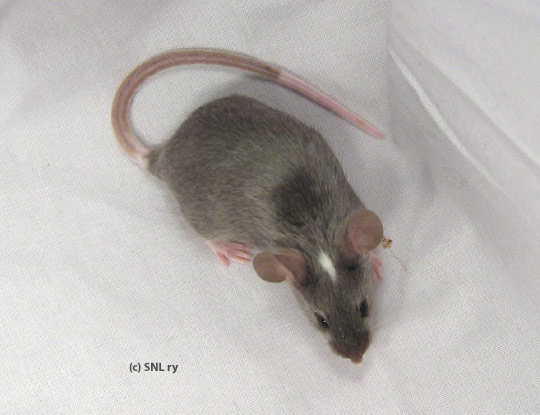Varieties
Undstandardized
Berkshire (*/brk)
s/s + modifiers (k10).
"With the exception of fox varieties, a mouse of any standardized colour, with a symmetrical white spot on the forehead. A symmetrical white rectangular spot on the belly, beginning between the forelegs and ending between the hind legs. Feet stops are required, not running into the belly markings. Tail stop to be at most halfway along the tail. White to be pure and devoid of any coloured spots or markings, the coloured back and sides to be devoid of any white spots. A white spot on the lower jaw is not the considered a disqualifying fault. Eye colour to be as in standardized variety."
Breeding information below the pictures.
Quick Look
Berkshire is one of those varieties with uncertain genetic background. Berkshire is the "other half" of an older standard for berkshire, which proved to be trying to cover two different markings. This unworking (provisional) standard was split into a blazed, white bellied blazed and head and belly spotted berkshire. The genetics of the variety is rather uncertain, but the article on blazed deals with the W-theory, while this looks at the s-theory.
The W-theory
Berkshire mice with a variegated background are berkshire instead of variegated for the same reason that makes s/s-berkshire a berkshire instead of even/broken/misc s/s-spotted: it's all about modifiers. Like the recessive white spotting gene s, W has it's own set of modifiers. The general term is m(W)-complex (compare with k-complex of the s). In real life, this "complex" is a group of several different loci in different chromosomes, each affecting one part of how W white spotting appears on a mouse.
Silvers writes how some w/w mice of a W/+ (variegated) line occasionally had a belly spot and sometimes a white spot on the black. This, of course, has nothing to do with blazed mice as such, but shows how the correct set of modifiers can make a non-white spotted mouse show white spotting.
Furthermore, on some geneticist's sites I found pictures of W/+ mice (+ = wild type, w) with "berkshire" markings, along with description saying: "On most genetic backgrounds, W/+ adults have a moderate-sized white belly spot, white feet and white tail tip."
The point being: when a variegated x self combination produces berkshire (or blazed), the modifiers present in both parents and the combinations of these modifiers determine, whether the individual W/w mice born are variegateds or berkshires (and if the white is especially seen in the bellies of w/w mice).
(What's still unknown is, are our variegateds W/+ or Wv/+ , or if there are both of these genes around. Sources say contrasting things about the effects of these two genes. With Wv you'll get slightly bigger litters than with W, as most W/W young die in womb and are never born. Both genes are affected with anemia in homozygotes, Wv/Wv young surviving longer and with milder symptoms, W/W young tend to live only for a few days. It is also possible that our variegateds are of some other Wadd a number here mutation.)


